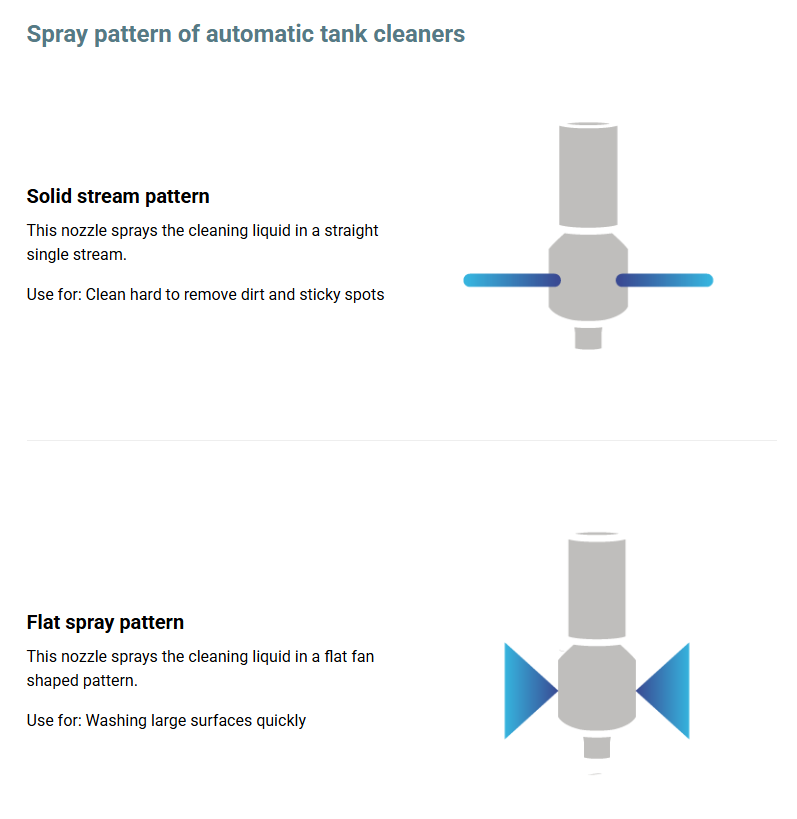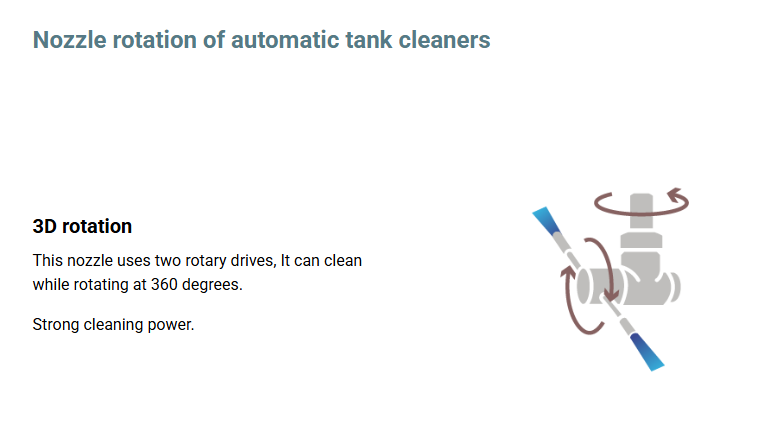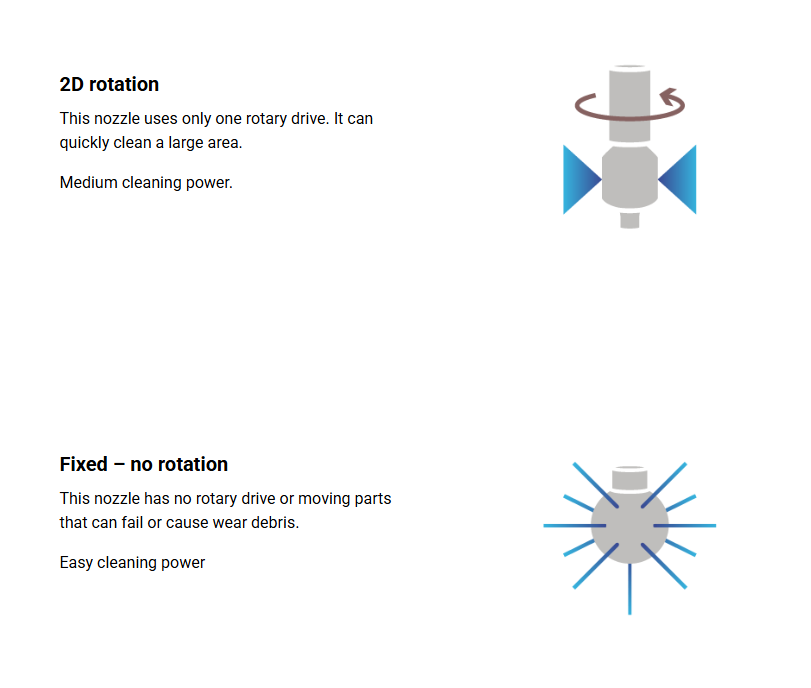
Automatic tank cleaner
Tank Size and Shape The size and shape of the tank are among the most important factors affecting your choice of the right automatic tank cleaner. The size of the tank directly affects the placement of the nozzles and flow capacity.
Size: High-flow and powerful nozzles are required for large tanks. For small tanks, lower flow but effective spraying nozzles may suffice.
Shape: Different nozzles may be required for cylindrical, conical, or specially shaped tanks. Choosing a nozzle suitable for the shape of the tank ensures that every area is effectively cleaned.
Cleaning Area The size of the area to be cleaned and inaccessible points affect the coverage and spray angle of the nozzles. The head of the automatic tank cleaner should clean enough area to cover every corner of the tank.
Coverage Area: It is important that the nozzle can rotate 360 degrees or move at a certain angle to completely clean the tank. Some models have a head that can rotate at a certain angle, which helps clean more area faster.
Cleaning Pressure The tank cleaner must have sufficient cleaning pressure to effectively remove dirt, oils, and other residues. Pressure is critical, especially in tanks where dirt is dense or viscous liquids accumulate.
High Pressure: High pressure is required for heavy dirt or stubborn residues. High-pressure nozzles clean dirt faster and more effectively.
Low Pressure: Lower pressure systems may be preferred in sensitive tanks or tanks containing thin materials.
Liquid Flow and Flow Rate The flow rate of automatic tank cleaners determines how much water will circulate in the tank. High-flow nozzles provide faster cleaning, but low-flow systems are ideal for more sensitive and controlled cleaning.
Flow Amount: The liquid flow rate should be determined according to the size of the tank and the time required for the cleaning process. Larger tanks require more liquid flow.
Flow Rate Adjustment: Some systems have features that can adjust the flow rate and speed. This provides flexibility in various tanks.
Working Environment and Chemical Compatibility The tank cleaner must be durable and compatible with the cleaning solutions used. Cleaners used for chemical cleaning processes should affect the material compatibility of the tank cleaner.
Material Selection: Materials such as stainless steel, PVC, and PTFE are compatible with chemical cleaners and provide long-term durability.
Chemical Resistance: Cleaners resistant to the chemicals inside the tanks should be selected. For example, nozzles resistant to acidic or alkaline substances may be preferred.
Energy Efficiency Energy efficiency is an important factor in reducing operating costs. Some automatic tank cleaners are environmentally friendly by using water and energy more efficiently.
Low Energy Consumption: Systems that perform effective cleaning at lower pressures can reduce energy consumption.
Water Saving: Smart systems or low-flow nozzles can be used to save water, especially in high-flow models.
Cost and Budget The prices of automatic tank cleaners may vary depending on the features and capacity of the system. High-quality, durable, and long-lasting systems are usually more expensive. However, in the long term, affordable systems may be more advantageous in terms of efficiency and maintenance costs.
Initial Investment: Initial costs vary depending on the technology used, capacity, and material quality.
Maintenance and Spare Parts Costs: Maintenance and spare parts costs of the systems should also be considered. It is important to consider regular maintenance requirements and spare parts supply.
Easy Maintenance and Cleaning Easy maintenance of automatic tank cleaners extends the life of the device and prevents malfunctions. Most automatic tank cleaners come with parts that can be cleaned after use. Apart from this, some models require less maintenance.
Easy Assembly and Disassembly: Easy assembly and disassembly of the tank cleaner facilitates maintenance operations.
Automatic Cleaning Features Automatic cleaning features of automatic tank cleaners are important to reduce maintenance requirements and ensure the device's longevity. These features save labor and time by ensuring the system operates efficiently.
Self-Cleaning Nozzles: Some automatic tank cleaners may have automatic cleaning mechanisms designed to clean their nozzles. This feature helps prevent blockages and ensures that the nozzles work effectively every time.
Cleaning Cycles: Some systems can enter automatic cleaning cycles at certain intervals. These cycles clean residues on the interior surface of the tank and eliminate nozzle blockages.
Low Maintenance Needs: Automatic cleaning features reduce the system's maintenance needs. This allows business owners to perform fewer manual interventions during cleaning operations and ensures the system operates efficiently for longer.
Self-Cleaning Filters: In some models, filtration systems are automatically cleaned. This feature ensures the continuous removal of dirt and residues, which is critical to maintaining the system's efficient operation.
Programmable Cleaning: Automatic cleaning features allow the user to create cleaning programs and automate cleaning operations at certain intervals. This provides regular and efficient cleaning, especially in large facilities.
These automatic cleaning features increase the performance of the tank cleaner while saving time and labor. It also helps maintain hygiene standards because the cleaning process is carried out more regularly and effectively.













